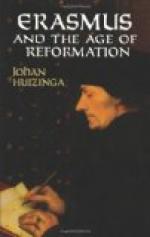Kyria chere geram cuius
ph[=i]lantr[)o]pos est bar, Per te doxa
theos nect[=e]n [)e]t
[)v]r[=a]n[)i]c[)i]s ymas.
In the commentary we are told that Kyria means the Virgin: but we are to be careful not to write it with two r’s, for kirrios means a pig (I suppose [Greek: choiros]), and it would never do to say Kirrieleyson. Chere is of course [Greek: chaire], salue. Geran (geram in the text) is interpreted sanctus, and seems from a lengthy discussion of it to be connected with [Greek: geron] and [Greek: ieros].[10] Philantropos (notice the quantities) is Christ, the Saviour. ’Bar Grece est filius Latine.’ ’Necten in Greco est venire Latine: vnde dicit Pristianus in primo minoris, antropos necten, i.e. homo venit.’ (For this remarkable form I can only suggest [Greek: enthein] or [Greek: hekein]: -en is probably the infinitive; ne might arise from en; and ct, through tt, from th.) Ymas is explained as nobis, not vobis. The construction of the distich is then given: ’Hail, sacred queen, whose son is the lover of men; through thee divine and heavenly glory comes to us.’
Again:
’Clauiculis
firmis theos antropos impos et ir mis
Figor ob
infirmi cosmos delicta, patir mi.’
Impos = in pedibus. Ir = a hand (probably [Greek: cheir], transliterated into hir, and h dropped) and mis is explained as = mei, according to the form which occurs in Plautus and early Latin. The lines are an address from Christ to God, and are interpreted: ’O my father, I God and man am fastened with hard nails in my feet and hands (upon the cross) for the sins of a weak world.’
Another work dictated to Erasmus at Deventer was the metrical grammar of Eberhard of Bethune in Artois, composed in the twelfth century. Its name, Graecismus, was based upon a chapter, the eighth, devoted to the elementary study of Greek—a feature which constituted an advance on the current grammars of the age. A few extracts will show the character of the assistance it offered to the would-be Greek scholar.
[10] Cf. Gerasmus
and Hierasmus as variations of the name
Herasmus
or Erasmus.
Quod sententia
sit b[)o]l[)e] comprobat amphibol[=i]a,
Quodque
fides br[)o]g[)e] sit comprobat Allobroga.
The gloss explains the second line thus: ’Dicitur ab alleos quod est alienum, et broge quod est fides, quasi alienus a fide’; and thus we learn that the Allobroges were a Burgundian people who were always breaking faith with the Romans.
Constat apud Grecos
quod tertia littera cima est,
Est
quoque dulce c[)i]m[=e]n, inde c[)i]m[=e]t[)e]rium;
Est [)v]n[)i]uersal[=e]
c[)a]t[)a], fitque c[)a]tholicus inde, ...
C[=a]ta
breuis pariter, c[=a]talogus venit hinc.
Die decas esse
decem, designans inde decanum ...
Delon
obscurum, Delius inde venit.
Ductio
sit gogos, hinc isagoga venit.
Estque
geneth mulier, inde gen[=e]th[=e][=u]m.




